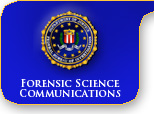
| Table of Contents | ||
| Back Issues | ||
| Search | ||
| Editors | ||
| About FSC | ||
| Submissions |
| Forensic Science Communications | October 2003 – Volume 5 – Number 4 |
| Standards and Guidelines | |
| Definitions, Recommendations, and Guidelines for the Use of Forensic Video Processing in the Criminal Justice System | |
| Scientific Working Group on Imaging Technologies (SWGIT) Version 1.2 June 2003 |
|
|
Mission
| Introduction
| Definitions
| Equipment Guidelines for Video Processing Standard Operating Procedures Steps for Processing Video Tape |
|
MissionThe mission of the SWGIT Forensic Video Subcommittee is to provide guidelines regarding video images and their capture, playback, processing, enhancement, storage, and output in a forensic environment. IntroductionThe purpose of this document is to provide definitions, recommendations, and guidelines for the use of video capture and processing to ensure the successful introduction of video imagery as evidence in a court of law. This section includes definitions, equipment used, guidelines for standard operating procedures, and general procedures for video processing. DefinitionsCD/DVD (compact disc/digital versatile disc): Optical disc formats designed to function as data storage media. Camcorder: A self-contained video camera and recording device. Capture card/frame grabber: A piece of computer hardware that converts an analog video signal to digital data. Deinterlacing: Separating an interlaced frame into two separate fields. Enhancement: Any process intended to improve the visual appearance of an image. Field: An element of a video signal containing alternate horizontal lines. In NTSC-interlaced video, the scanning pattern is divided into two sets (odd and even) of spaced lines that are displayed sequentially. Each set of lines is called a field, and the interlaced set of the two sets of lines is a frame. Forensic: Relating to or dealing with the application of scientific knowledge to legal problems, especially in relation to the detection of crime. Forensic video analysis: The scientific examination, comparison, and/or evaluation of video in legal matters. Frame: Lines of spatial information of a video signal. For interlaced video, a frame consists of two fields, one of odd lines and one of even lines, displayed in sequence. For progressive scan (noninterlaced) video, the frame contains samples starting from one instant and continuing through successive lines to the bottom of the frame. Interlaced scan: Video image format. The video frame consists of two fields. The first field contains all the odd-numbered horizontal lines and the second field all the even-numbered lines. Monitor: An electronic device used to display live or recorded images. Multiplexer/demultiplexer (muxer/demuxer): A device used to combine multiple video signals into a single signal or separate a combined signal. These devices are frequently used in security and law enforcement applications for recording and/or displaying multiple camera images simultaneously or in succession. NTSC: National Television Standards Committee. Output: The means by which an image is presented for examination or observation. Playback: Recorded material viewed and heard as recorded, facilitated by camcorder, videocassette recorder, or other device. Processing: Any activity that transforms an input image and/or signal into an output image and /or signal. Production switcher: A device used to mix video signals from two or more sources (e.g., cameras, videocassette recorder/players, time-base correctors, character generators) for dissolves, wipes, and other transition effects. Routing switcher: A device used to direct the path of one or more signals into one or more devices. Time-base corrector (TBC): An electronic device used to correct timing inconsistencies and stabilize the playback of the video signal for optimum quality. It also synchronizes video sources allowing image mixing. Time-lapse videocassette recorder: A type of video recorder that can be set to record continuously over long periods, achieved by the tape moving in steps and recording one frame or field at a time. These devices are frequently used in security and law enforcement applications. Vectorscope: An electronic device that measures a video signal's chrominance (color) performance. Video: The electronic representation of a sequence of images, depicting either stationary or moving scenes. It may include audio. Video distribution amplifier: A device used to divide single video signals, while boosting their strength for delivery to multiple video devices. Videocassette recorder (VCR): Multifunction machine intended primarily for playback and recording of videotape stored in cassettes. Waveform monitor: An electronic device that provides a graphic display of a video signal's strength. EquipmentThe purpose of this section is to identify some of the equipment used to view, process, and enhance video images. Playback devices must be capable of producing an accurate representation of the recorded image. Playback devices include but are not limited to the following:
Processing/Enhancement
Output/Storage
Guidelines for Video Processing Standard Operating ProceduresTITLE: Video Processing Standard Operating Procedures PURPOSE: To apply processing techniques intended to enhance and/or analyze video images. Note: The successful processing of video images should be made with regard to the four legal tests: reliability, reproducibility, security, and discovery. EQUIPMENT: The agency should address the following minimum equipment requirements: Hardware
Software
PROCEDURES: Agencies should establish specific step-by-step procedures for video processing in accordance with SWGIT guidelines and agency requirements. These procedures should address the following, as a minimum:
CALIBRATION: If necessary, agencies should develop procedures specific to their needs. CALCULATIONS: If necessary, agencies should develop procedures specific to their needs. LIMITATIONS: Agencies should take into consideration budget, equipment, management, and accrediting agency requirements. SAFETY: Agencies should develop procedures specific to their needs. REFERENCES: Agency-specific documentation, manufacturers' manuals, and SWGIT guidelines. TRAINING: Agencies should document procedures to ensure sufficient training to afford competence and proficiency with applicable video processing. (See Guidelines and Recommendations for Training in Imaging Technologies in the Criminal Justice System at www.fbi.gov/hq/lab/fsc/backissu/april2002/swgittraining.htm). Steps for Processing VideotapeAgencies should establish specific step-by-step procedures for video processing in accordance with SWGIT guidelines and agency requirements. These procedures should address the following, as a minimum.
|
|